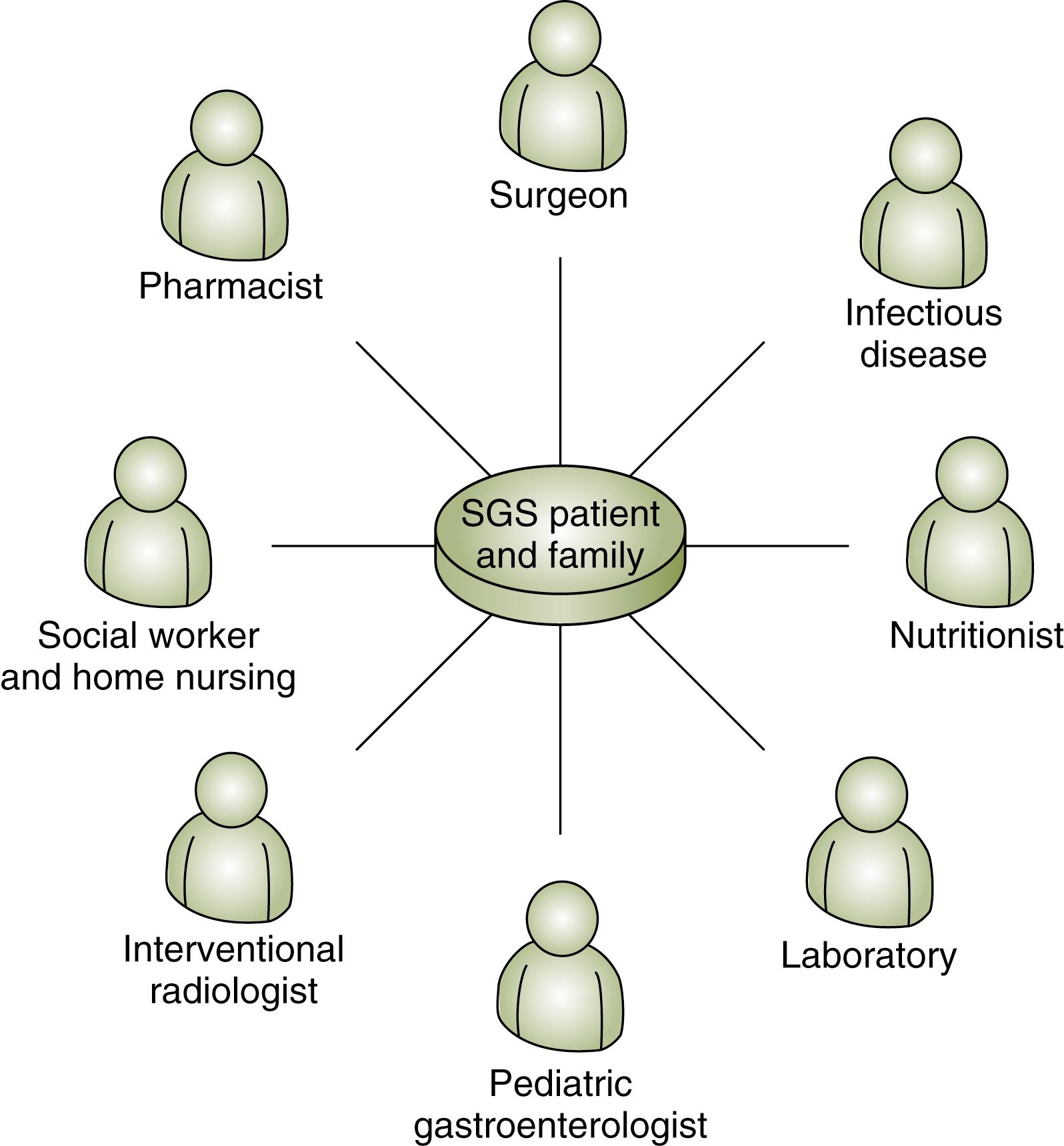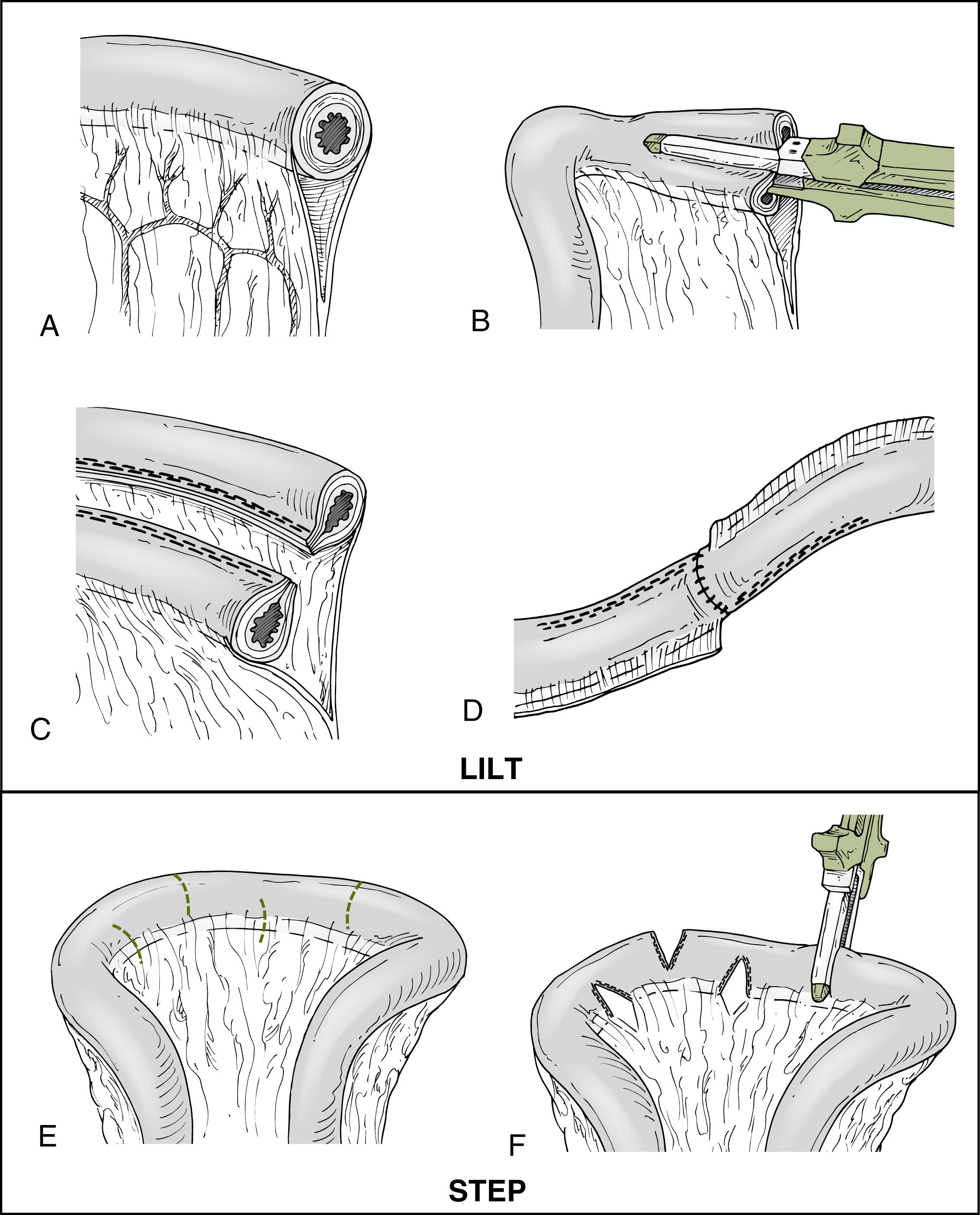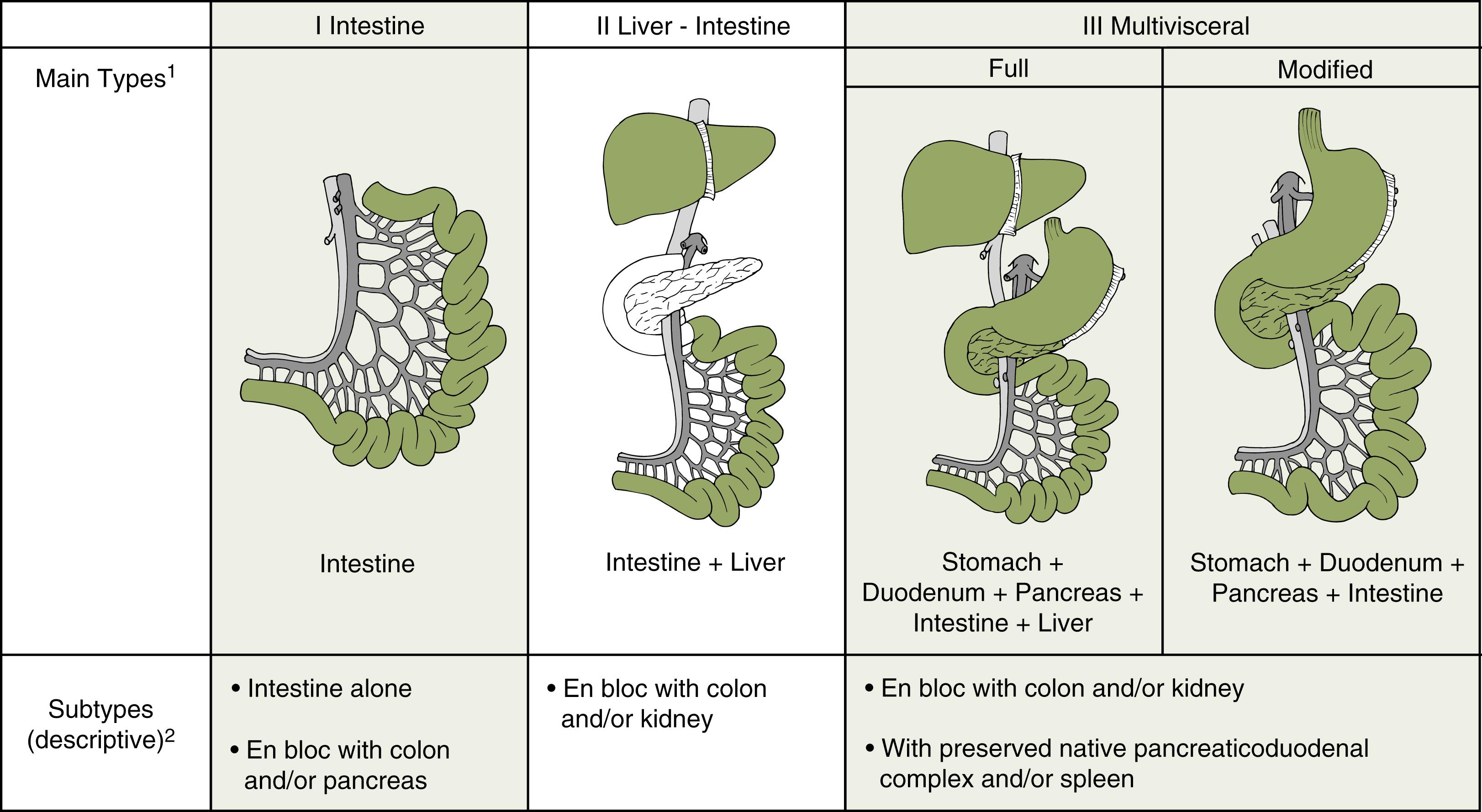Physical Address
304 North Cardinal St.
Dorchester Center, MA 02124
Continuous progress has been made over the last few decades in the management of children with intestinal failure. Significant advances include gut rehabilitation, autologous reconstruction, bowel lengthening, and visceral transplantation. Gut replacement is one of the most important milestones in the recent history of organ transplantation. Improved donor management, refinement of surgical techniques, introduction of new immunosuppressive protocols, and improved follow-up care have led to increased survival. As a result, intestinal and multivisceral transplantation is now an established treatment option for these unique patients. Congenital diarrhea disorders have been better characterized recently with the potential to further expand the indications for intestinal transplantation. From the immunological standpoint, the impact of donor-specific antibodies (DSAs) on post transplant outcomes has received increased attention and stimulated the modification of the immunosuppression protocols. With the increasing number of patients surviving gut transplantation, quality of life (QoL) has become an important aspect of the outcome measures after transplantation. In this chapter we describe recent advances in gut rehabilitation and visceral transplantation with special emphasis on newly characterized congenital disorders requiring transplantation, the evolving role of DSA, and the current long-term outcomes, including QoL.
Short gut syndrome includes a constellation of symptoms related to reduction in the length of small bowel below a nutritional threshold that is specific for every patient. Symptoms include chronic diarrhea, electrolyte and fluid imbalances, malnutrition, weight loss, stunted growth, kidney injury, and other metabolic deficiencies. Most patients require total parenteral nutrition (TPN) and are at risk of life-threatening complications including line infection, central vein thrombosis, hepatic injury, and other metabolic morbidities. Intestinal insufficiency is anatomic , resulting from bowel resection, or physiologic, as a consequence of mucosal pathologies such as tufting enteropathy, microvillus inclusion disease, or neuromuscular disorders including total aganglionosis and gut dysmotility such as pseudo-obstruction. In neonates, short gut syndrome is usually resulting from congenital malformations, whereas in adolescents volvulus, trauma, and desmoid tumors are more prevalent ( Box 36.1 ). The severity of intestinal insufficiency is determined by the length and location of the intestinal loss: a proximal jejunostomy is associated with high output losses. Nonetheless, loss of nutritional autonomy is related to a combination of loss of enteric secretions, inability to eat, and rapid transit time, particularly in patients with ultra-short gut syndrome, diverting stoma, disconnected gut, and with loss of the ileocecal valve (“ileal brake”) with reduction in glucagon-like peptide 1 (GLP1) and other peptides.
Short gut syndrome
Gastroschisis
Necrotizing enterocolitis
Intestinal atresia
Volvulus
Trauma
Radiation enteritis
Crohn’s disease
Dysmotility syndrome
Neoplastic disorders
Tumor-like desmoids associated with familial adenomatous polyposis
Enterocyte dysfunction
Aganglionosis
Microvillus inclusion disease
Tufting enteropathy
Congenital diarrhea and enteropathy
Portomesenteric thrombosis
The residual intestinal length and its functional capacities determine the propensity to develop intestinal failure. In general, the threshold below which patients will need parenteral nutrition is residual intestinal length of 30% or less. Otherwise, patients can be supplemented with enteral nutrition, increased caloric intake, and forced hyperphagia. Following an acute loss in the length of functioning bowel, the remaining bowel undergoes an adaptation process with a hyperplastic response. The degree of hyperplasia is dependent on the health of the residual bowel, blood supply to the remaining bowel, and optimum nutrient intake. Enterocyte hyperplasia leads to lengthening of villus-crypt units and increase in absorptive surface area. At the molecular level, there is increase in the level of enzyme and transport molecules per crypt. Such a natural adaptation process continues for many years along with the linear growth of the gut during childhood and adolescence. Patients with mucosal abnormalities or pseudo-obstruction have limited capacity to adapt, and changes seen in patients with reduction in bowel length may not apply to patients with these disorders.
Interruption of enterohepatic circulation after resection of the small intestine often results in progressive liver disease, unlike patients who are receiving parenteral nutrition without short gut. Enteral calories and intravenous lipid derived from fish oil may prevent cholestasis and liver injury. Recent data have demonstrated that omega-3 fatty acids are associated with chemical reversal of parenteral nutrition–associated cholestatic liver disease. Bacterial overgrowth results from excessive bacterial proliferation because of blind loop or absence of ileocecal valve. Symptoms include excessive bloating, flatulence resulting from enterocyte injury, and inactivation of bile acids via deconjugation. It leads to a deficiency of vitamins, especially B 12 , A, D, E, and K. Therapy includes gut decontamination with oral Flagyl or trimethoprim-sulfamethoxazole and gentamicin. Pancreatitis is a well-known complication of TPN that is exacerbated by the development of gallstones. Consequently, patients can develop endocrine and exocrine dysfunction and require replacement therapy with insulin and pancreatic enzymes. Central vein thrombosis and catheter-related bloodstream infection with sepsis, endocarditis, and brain microinfarctions are known complications of prolonged TPN. All of the preceding complications including metabolic derangement and renal insufficiency due to frequent dehydration can be an indication for gut rehabilitation including transplantation.
Medical, nutritional, and surgical interventions for gut rehabilitation play a special role in infants and small children, given their greater intestinal adaptive capacity compared to adults. With a coordinated multidisciplinary approach, selected children with short bowel can be weaned from parenteral nutrition and achieve enteral autonomy. In the early phase following loss of bowel length or function, therapy is focused on fluid and electrolyte replacement. Early restoration of intestinal continuity, liberal use of continuous gastrostomy feedings, administration of hypocaloric elemental formulas to optimize enterocyte absorption, use of operative bowel-lengthening techniques in dilated bowel, and aggressive antibiotic treatment of bacterial overgrowth are mainstays of intestinal rehabilitation.
In the early postoperative period, patients require parenteral nutrition via a peripheral or central line. After resolution of ileus and if there are no confounding factors, enteral feeding is started in the form of formulas and breast milk for infants. Depending on age, nutritional requirements, and ability to take orally, formula and amount of tube feeding are modified with the help of nutritionists who are instrumental in the management of these patients. A well-hydrated patient with rising albumin, weight, reduction in fecal volume, and normal laboratory values on enteral nutrition indicates that TPN weaning is warranted. Care is taken to ensure oral replacements include trace elements and vitamins, and therapy is guided by periodic testing of laboratory values of these. Failure of TPN withdrawal is usually seen in patients with diseased remaining bowel, ultra-short gut length (<40 cm), absence of ileocecal valve, and loss of colon. Thus, failure of enteral therapy, total loss of small bowel, dysmotility, and mucosal disorders are absolute indications for long-term parenteral nutrition at home. This is supported by a multidisciplinary team of providers that includes home nursing, pharmacists, nutritionists, and the gastrointestinal physician.
A multidisciplinary approach is essential to the success of any intestinal rehabilitation program. Patients are evaluated by pediatric gastroenterologists, pediatric general surgeons, intestinal failure nutritionists, pharmacists with advanced training in parenteral nutrition, and social workers ( Fig. 36.1 ). Depending on residual intestinal length, patients may require antimotility agents such as loperamide, diphenoxylate, atropine, or tincture of opium. Cholestyramine and octreotide are of limited benefit. In addition to the standard nutritional measures, enterocyte growth factors have been utilized increasingly to promote gut adaptation.

In selected patients, the use of enterocyte growth factors enhances the adaptation process and increases the chances of achieving nutritional autonomy. Teduglutide is a recombinant analog of human glucagon-like peptide 2 (GLP2) approved in the United States (Gattex) and Europe (Revestive) as the first targeted treatment of short bowel syndrome–associated intestinal failure. It increases crypt epithelial proliferation, reduces epithelial apoptosis, and enhances visceral blood flow and nutrient absorption with the goal of decreasing parenteral nutrition requirements. Parameters of successful gut rehabilitation include enteral autonomy (discontinuation of TPN for more than 3 consecutive months), reduction in parenteral caloric requirements, and reduction in serum-conjugated bilirubin. In a 12-week phase 3 study involving 40 patients (age 1 to 17 years) from 17 intestinal rehabilitation programs in the USA and UK, parenteral volume requirement decreased by 25% to 41% and parenteral calories by 45% to 52% while increasing enteral volume and calories; 4 patients were weaned from PN at the end of the study. However, 2 of them required resumption of PN 4 weeks after termination of the study. Teduglutide was generally well tolerated; the most commonly reported side effect was vomiting, especially in moderate–high dose regimens (0.025 mg/kg/day to 0.05 mg/kg/day) compared to a low dose regimen (0.0125 mg/kg/day). The short study period (12 weeks) did not allow for evaluation of the effects after prolonged treatment and impact on growth.
Failure of supportive and medical therapy, especially in patients with dilated small bowel, is an indication for surgical intervention to enhance gut adaptation to intestinal failure. Small bowel dilatation (≥4 cm) is associated with dysmotility and bacterial overgrowth, predisposing to septic complications from bacterial translocation, D-lactic acidosis, and malabsorption. In addition to the length of remaining small bowel and the presence of the ileocecal valve, small bowel dilatation impacts weaning from PN and survival.
Patients with atretic bands, obstructed bowel loops, and dilated bowel segments need surgical exploration. Oftentimes patients develop enterocutaneous fistulae or intra-abdominal abscesses that need to be surgically repaired or drained, respectively. Successful, calculated surgical intervention can restore native gut function and preclude the need for intestine transplantation.
The technical feasibility of visceral transplantation and improved outcomes has stimulated the introduction of different nontransplantation surgical procedures to treat intestinal failure and complex abdominal pathology, including autologous reconstructive and bowel-lengthening procedures ( Fig. 36.2A–E ). With transplantation being utilized as a rescue therapy, surgical reconstruction has been increasingly applied in patients with multiple entero-cutaneous fistulae and residual bowel function. Dilated segments of the bowel can be lengthened by one of the two well-known and innovative techniques. Both modalities can be successfully performed in patients with dilated bowel loops to reduce transit time, eliminate bacterial overgrowth, and enhance gut absorption. These include longitudinal intestinal lengthening and tailoring (LILT) introduced by Bianchi and serial transverse enteroplasty (STEP) reported by Kim et al. Indications, selection criteria, and outcome measures are summarized in Table 36.1 . In general, the Bianchi procedure requires a minimum of 20 cm of small bowel, whereas the STEP procedure can be performed on any length of bowel. In selected children with short bowel and absent ileocecal valve, tapering surgery increases bowel length by up to 50% and achieves enteral autonomy in 59% to 75%, comparable to patients with longer remnant intestine and retained ileocecal valve not requiring tapering surgery. Repeat STEP can be performed in selected patients to achieve full enteral autonomy. One of the potential complications of STEP is postoperative stricture resulting from excessive reduction (<2 cm) of the intestinal lumen.

| Longitudinal Intestinal Lengthening and Tailoring, Bianchi | Serial Transverse Enteroplasty, Kim et al. | |
|---|---|---|
| Indication | Loss of Nutritional Autonomy | |
| Age | Any age, preferably after 6 months | Any age |
| Recommended anatomy | 20–40 cm dilated bowel | Any length |
| Minimal intestinal diameter and length | 3–5 cm along a length of 20 cm | 4 m, any length |
| Associated liver disease | Can be done in the presence of early fibrosis | Can be done in the presence of early fibrosis |
| Intestinal lengthening | 1.25- to 2-fold | 1.4- to 2.2-fold |
| Reversal of liver disease | Yes | Yes |
| Ability to repeat procedure | None | Possible |
| Complications | Perforation, ischemia | Bleeding, microperforation |
In addition to bowel reconstruction techniques, creative efforts have been made to treat unresectable abdominal malignancies by ex vivo tumor resection and gut auto-transplantation. Failure of autologous intestinal rehabilitation should prompt the need for early transplantation with expected better outcomes. The indications for early referral and transplantation to prevent irreversible neurologic and psychosocial impairments that may have a significant impact on the procedure’s rehabilitative therapeutic indices are summarized in Box 36.2 .
Massive small bowel resection
Severely diseased bowel and unacceptable morbidity
Microvillus inclusion disease
Persistent hyperbilirubinemia
Venous thrombosis of upper body veins
Dysmotility
Portomesenteric thrombosis
Evolution of small bowel transplantation is the result of continual interplay between new advances in surgical techniques, novel immunosuppressive strategies, and better postoperative management. , With new insights into the mechanisms of allograft acceptance and other important predictors of long-term functional survival, further progress has been made. Improved postoperative management and better long-term therapeutic efficacy, particularly of the liver-free visceral allograft, has led to improved results.
With FDA approval of tacrolimus and the initial encouraging results with intestinal and multivisceral transplantation, there was a resurgence of clinical interest in the field across major transplant centers. , Clinical application of the procedure has gradually increased, with promising outlook especially after the 2000 approval of Centers for Medicare & Medicaid Services (CMS) considering intestinal, liver–intestinal, and multivisceral transplantation procedures as standard of care for patients with irreversible intestinal failure who no longer can be maintained on parenteral nutrition.
The three main procedures include intestine, liver–intestine, and multivisceral transplantation with the adoption of a new subclassification according to the type of added organs introduced by the senior author of this article (KA). This nomenclature set the stage for future reporting metrics and outcome analysis. It has been accepted by major professional transplant societies ( Fig. 36.3 ).

Become a Clinical Tree membership for Full access and enjoy Unlimited articles
If you are a member. Log in here